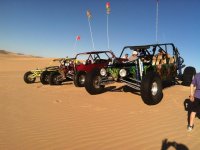Define scrub for us and how it would affect sand cars.
I think of it like this - caution some math involved to do it right, but I'll leave that out ...
If you draw a line top to bottom through the upper and lower Rod ends or Uniballs (ball joints on regular cars) where they attach to the spindle and down to the ground (vertical)
In a well designed front end it would touch the ground under the center of the tire where the tire touches the ground (center of the Contact Patch) like drawing line top to bottom through the center of the tire
Think of the tire turning on a single point like the point of a nail that what a centered scrub would be like - when is not set like that the Tire "scrubs" the ground as it turns
If you move the tire out then the two points don'r match (same is if you move the tire in) when you move the tire out thats Positive scrub, if you move it in thats negative scrub
If you have too much positive scrub the car will feel a bit more stable going straight (like positive caster) but when you turn its very hard on the steering rack and given we are in sand and, sand pushes against the tire, it will tend to push the tire to turn in or out harder (accelerated the turn) - If you have PS you will just feel the car fighting a bit, if you let go of good grip on the wheel in a turn the car goes full lock really fast (aka roll over) but the steering rack mounting and tie rod mounting on the spindle takes a lot of pressure (the reason guys put big tires on the Spindle breaks the tie rod mount off (J Alper posted those pics alot in past)
If you go negative the car will resist accelerating turning in or out, so high speed stable or if you get a flat the wheel won't turn as hard and you probably won't roll over. So a little Negative is better than a little Positive, but too much negative makes steering slow and unresponsive (like a 1980's Mercedes if you ever drove one of those)
On road cars getting all that wrong makes the car handle like crap - sand is forgiving, but way easier to break stuff (spindles, rod ends, tie rod mounts on spindles, wheels, bearings, steering rack) when its set up wrong and greater possibility of flipping the car
Some cars you see never break stuff - thats partially why ...
Hope this helps ...



